The 9-Step Business Model Canvas: A Tool for Business Analysis
- See the World at Work The 9-Step Business Model Canvas: A Tool for Business Analysis
“Do you have one simple picture that captures your overall strategy, a picture that every manager understands and that puts everyone on the same page?”
That’s the question that W. Chan Kim and Renée Mauborgne ask in the opening of their section on understanding where your business is in the present in their book Blue Ocean Shift: Proven Steps to Inspire Confidence and Seize New Growth.
What factors are your industry or target industry competing on and investing in? What currently sets your product or service offering apart, and how does it diverge from your competition? Basically, is there an objective understanding of the current state of play in your industry from you and your team?
In today's rapidly changing business landscape, companies must constantly assess and adapt their strategies to stay competitive. If you want to make sure you understand your industry’s status quo, then it’s important that you have a clear and shared picture. Clarity is necessary because it shows that you actually have a strategy, not just a collection of tactics. The shared picture is important because it ensures that everyone is on the same page.
A major mistake made by many start-ups around the world is focusing on the technology, the software, the product, and the design, but neglecting to ever figure out the business. And by “business” we simply mean how the company makes money by acquiring and serving its customers. – Reid Hoffman
This is a great quote from Hoffman because it demonstrates a loss of vision and clarity that can so often occur within the business setting. So, how can businesses move from being bogged down by their day-to-day activities and move towards a strategic, overall vision for their business?
Enter the business model canvas.
This visual framework offers a systematic approach to analyzing and innovating business models. Let’s take a closer look at this model.
What is the Business Model Canvas?
Developed by Alexander Osterwalder, a Swiss entrepreneur and co-founder of Strategyzer, and Yves Pigneur the Business Model Canvas is a strategic management tool that provides a holistic view of a company's operations and how it creates, delivers, and captures value. It consists of nine key building blocks that represent different facets of a business:
- Customer Segments
- Value Propositions
- Channels
- Customer Relationships
- Revenue Streams
- Key Resources
- Key Activities
- Key Partners
- Cost
When laid out on the one-page model, the canvas looks like this:
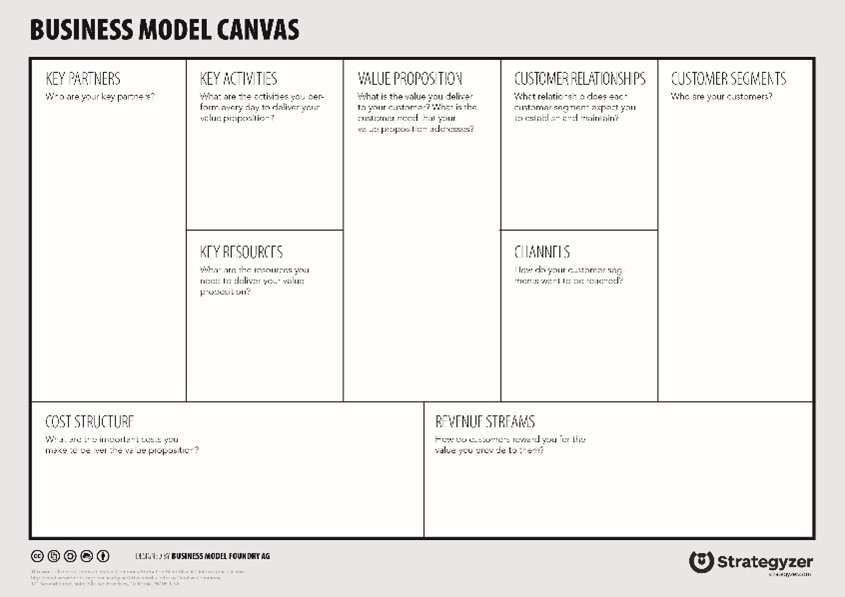
This tool allows businesses to visualize and communicate a simple story of their existing business model. One article from The Power Business School says that the canvas allows you to carry out a high-level analysis without drilling down and getting lost in the details.
It’s a visual overview of your entire business on a single canvas.
How Do I Start?
To start filling out the business model canvas, just start by breaking it down into its 9 basic blocks and analyze them each individually.
Try to get the decision-makers and leads from your various departments together and proceed to break down each of these segments and discuss how they relate to your business.
Let’s get started then and analyze each of the nine sections. I will be using an example Business Model Canvas from Gary Fox centered around Netflix.
Customer Segments
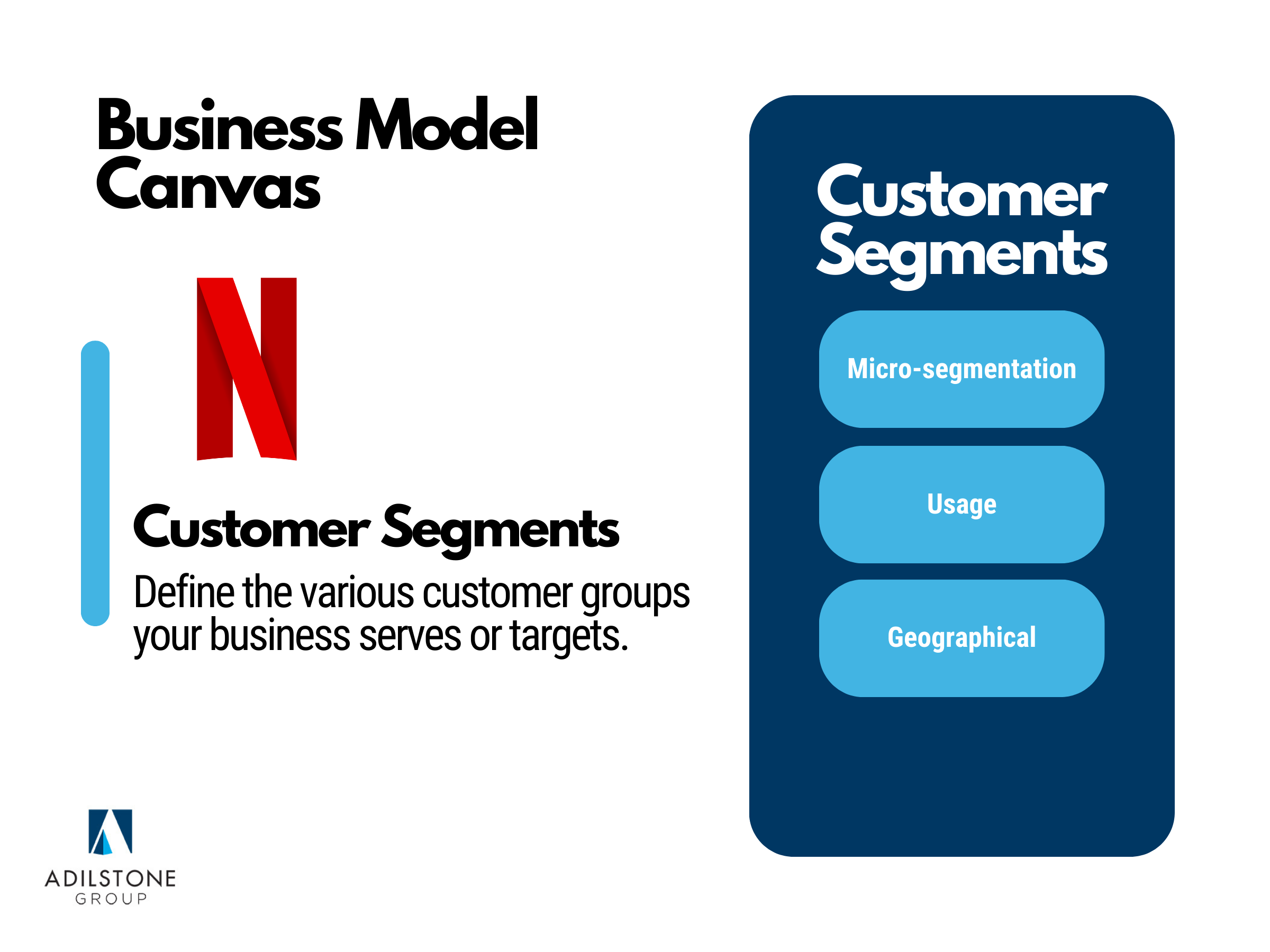
The "Customer Segments" block is a critical component of the Business Model Canvas because it forces businesses to define and prioritize their target audiences. Customer segmentation involves categorizing your customer base into distinct groups based on shared characteristics, needs, and behaviors.
As we look at Netflix’s Customer Segments, we notice that there is micro-segmentation, usage, and a geographical segment.
Netflix’s micro-segmentation strategy involves dividing its 125 million global viewers into 2,000 “taste clusters” that group people based on their movie and TV show preferences. These profiles that a viewer is clustered into drives what they see on Netflix and what is recommended to them. So, Netflix was able to use customer segmenting based on actual customer behavior to further segment their customers to provide unique value to them.
Usage segmentation deals with which screens a viewer uses to watch a show on Netflix (TV, phone, etc.), when they used them, where they used them, and how often they used them. This data helps Netflix further segment their customer base.
Finally, Netflix investigates geographical data to further develop customer segmentation. This data is used for ad targeting and localization of content.
Once a business knows who they are targeting, it is now time to look at what they offer.
Value Propositions
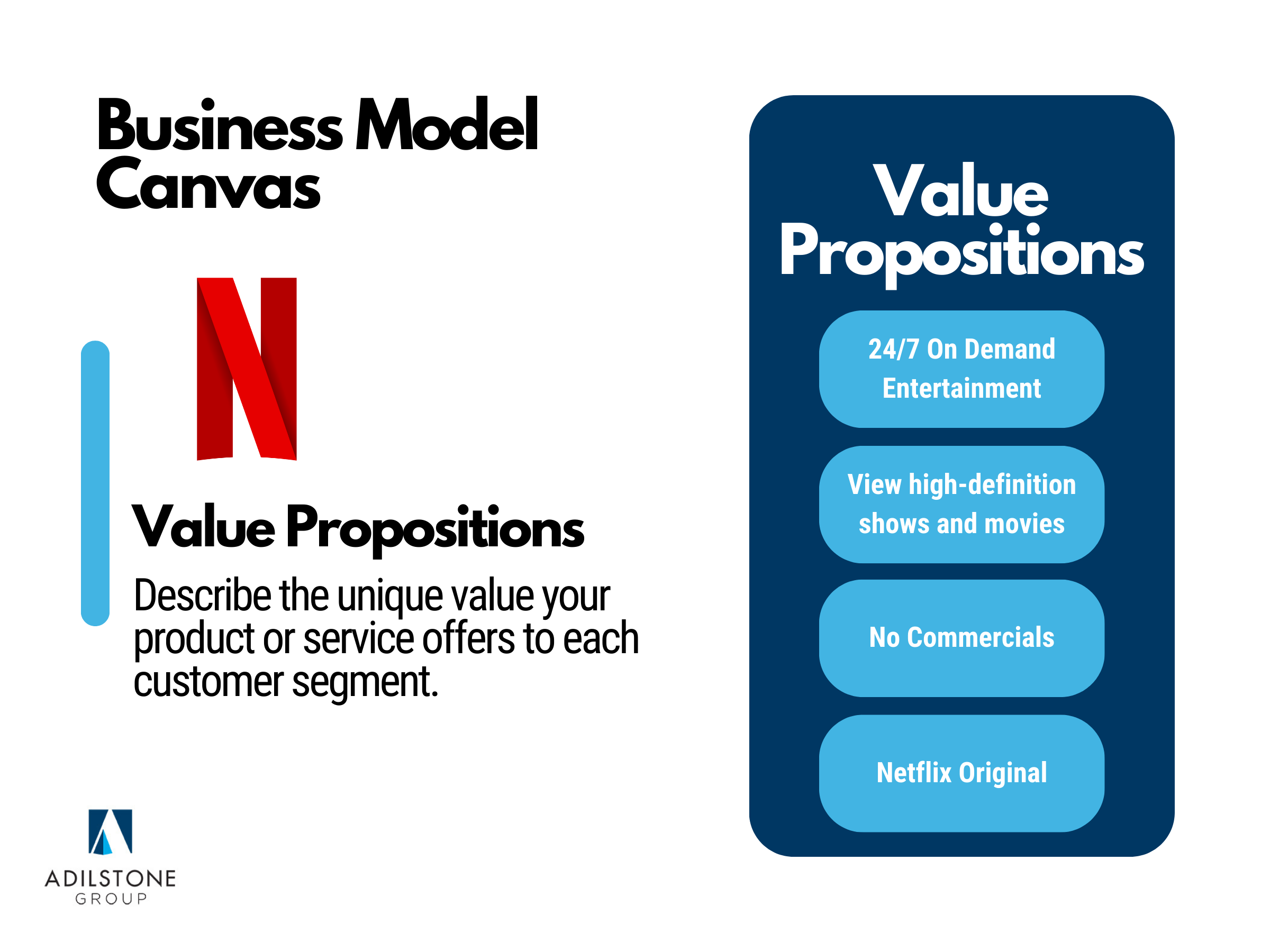
This second block of the business model canvas is about your company’s value propositions. More importantly, it’s about figuring out what makes your customers turn over to you. Which of their problems do you solve best? This is known as your Unique Value Proposition (UVP).
Some great questions to ask when finding your value propositions are:
- What Problem Does Our Product/Service Solve?
- How Does Our Product/Service Benefit Customers?
- What Makes Us Unique?
- Why Should Customers Choose Us Over Competitors?
- What Pain Points or Fears Does Our Product/Service Alleviate?
So, let’s look at Netflix again.
One of their biggest value propositions is access to a huge library of content that is available 24/7 to all their customers. On-demand streaming paired with their content library is a huge value proposition.
Their original content also provides what would likely be a unique value proposition. As we look to answer why customers would choose to watch Netflix over another streaming service, we can safely assume that shows like Stranger Things, The Witcher, and Wednesday give it a unique value over its competitors.
Now let’s look at the company’s channels.
Channels
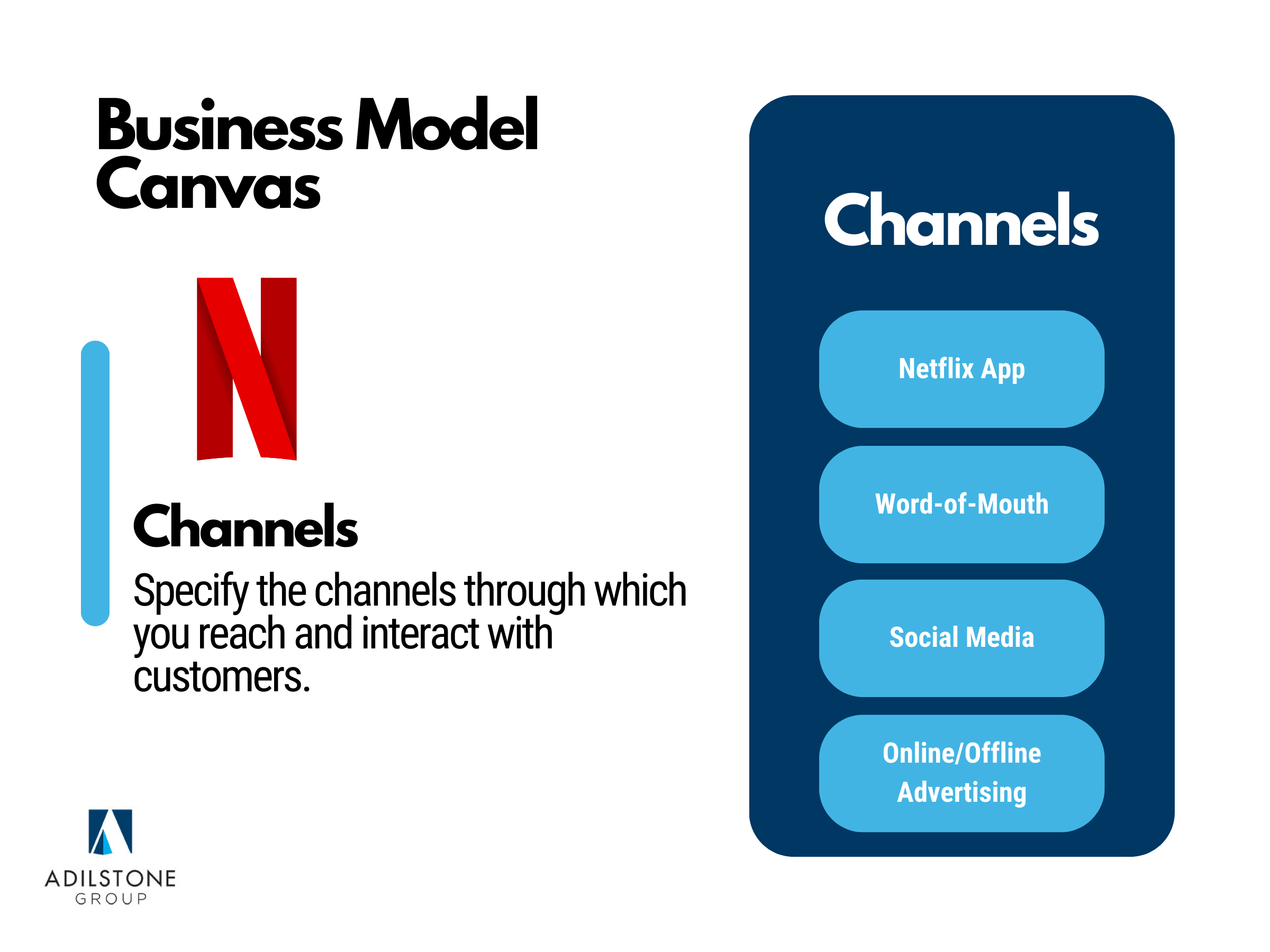
In this step, a company should ask themselves how they reach their customers and which channels they utilize.
Netflix has six primary channels through which they reach their audience:
- Any Device
- Netflix App
- Word-of-Mouth
- Online Advertising
- Offline Advertising
- Social Media
Netflix customers can genuinely interact with the company throughout almost every aspect of their daily life. Whether it’s through a billboard on the highway on their way to work, the downloaded app on their phone, Netflix’s popular social media presence, or a friend telling them to go watch the latest Netflix Original, Netflix has a sure way of interacting with just about everyone whether customer or non-customer.
Now let’s move onto customer relationships.
Customer Relationships
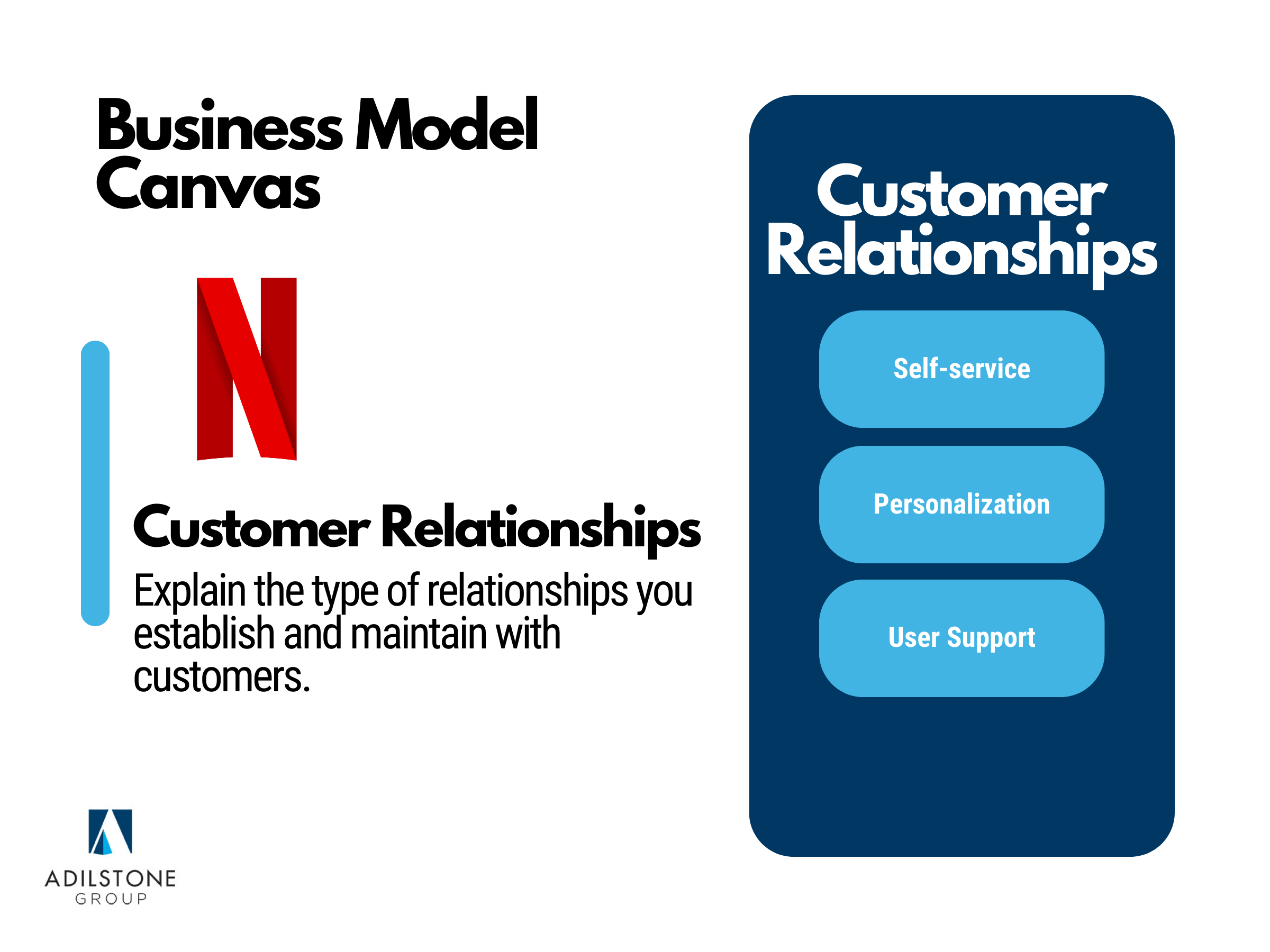
This section of the business model canvas deals with how a company can build, nurture, and grow the relationships it has fostered through customer acquisition.
Here’s a look at 3 key areas through which Netflix builds its customer relationships:
- Self-service
- Personalization
- User Support
Netflix interacts with customers simply through means of its business model. Customers log in directly to Netflix’s service through the app on mobile, TV, tablet, etc.
Netflix is renowned for its advanced algorithms that analyze viewer data to provide personalized content recommendations. These algorithms consider viewing history, preferences, and even viewing habits at different times of the day. By tailoring content to individual tastes, Netflix enhances customer satisfaction and keeps subscribers engaged.
Finally, Netflix places a strong emphasis on customer support. They provide various channels for customers to seek help, including chat support, email, and phone support in some regions. Swift and effective responses to customer inquiries and issues help maintain a positive customer experience.
Netflix’s focus on delivering a seamless and enjoyable viewing experience has helped it maintain a vast and loyal subscriber base in a highly competitive industry.
Now we move onto revenue streams.
Revenue Streams
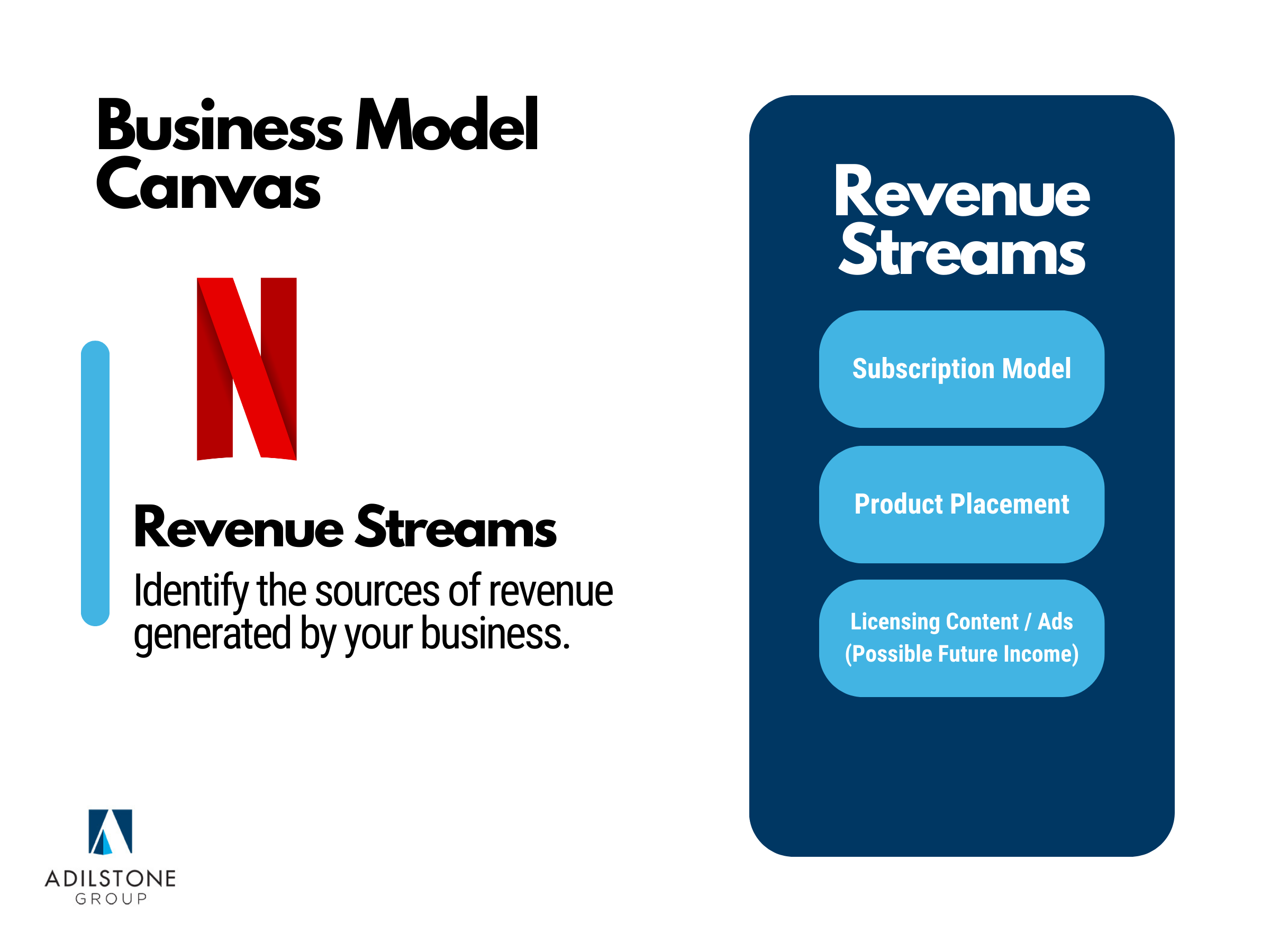
Now that we have defined the channels through which you reach your customers and defined the various ways in which you build and nurture your relationships with customers, we must look at how to capture the value you have created for your customers.
Netflix captures this value through one main revenue stream but there are other streams running into their business as well as possible future streams.
- Subscription Model
- Product Placement
- DVD Rental (no more)
- Licensing Content (possible future stream)
- Ads (possible future stream)
Subscription revenue is the core of Netflix's business model. Subscribers pay a monthly fee to access Netflix's vast library of movies, TV shows, documentaries, and other content. Netflix offers three subscription tiers with different pricing and features, allowing customers to choose plans that suit their needs and budgets.
Netflix also engages in partnerships and sponsorships such as product placements, marketing tie-ins, and co-branded campaigns, which create another revenue stream.
A future income stream Netflix may begin to offer is to license its own content. It already does this, especially through the licensing of its content for merchandising, but there is the potential for it to look to license more of its content, potentially even some of its original content.
Recently, Netflix has begun venturing into theatrical releases which allows them to generate revenue through box office revenues, but the company is still acting hesitant in this area, especially as demonstrated by its extremely limited release of Glass Onion.
Finally, another revenue stream is the addition of ads to their content. Netflix recently introduced an ad tier to their various tiers of subscriptions so we will continue to see how that affects their revenue and customer base.
Now that we have defined some revenue streams, let’s turn to look at the key resources needed to deliver on the value propositions.
Key Resources
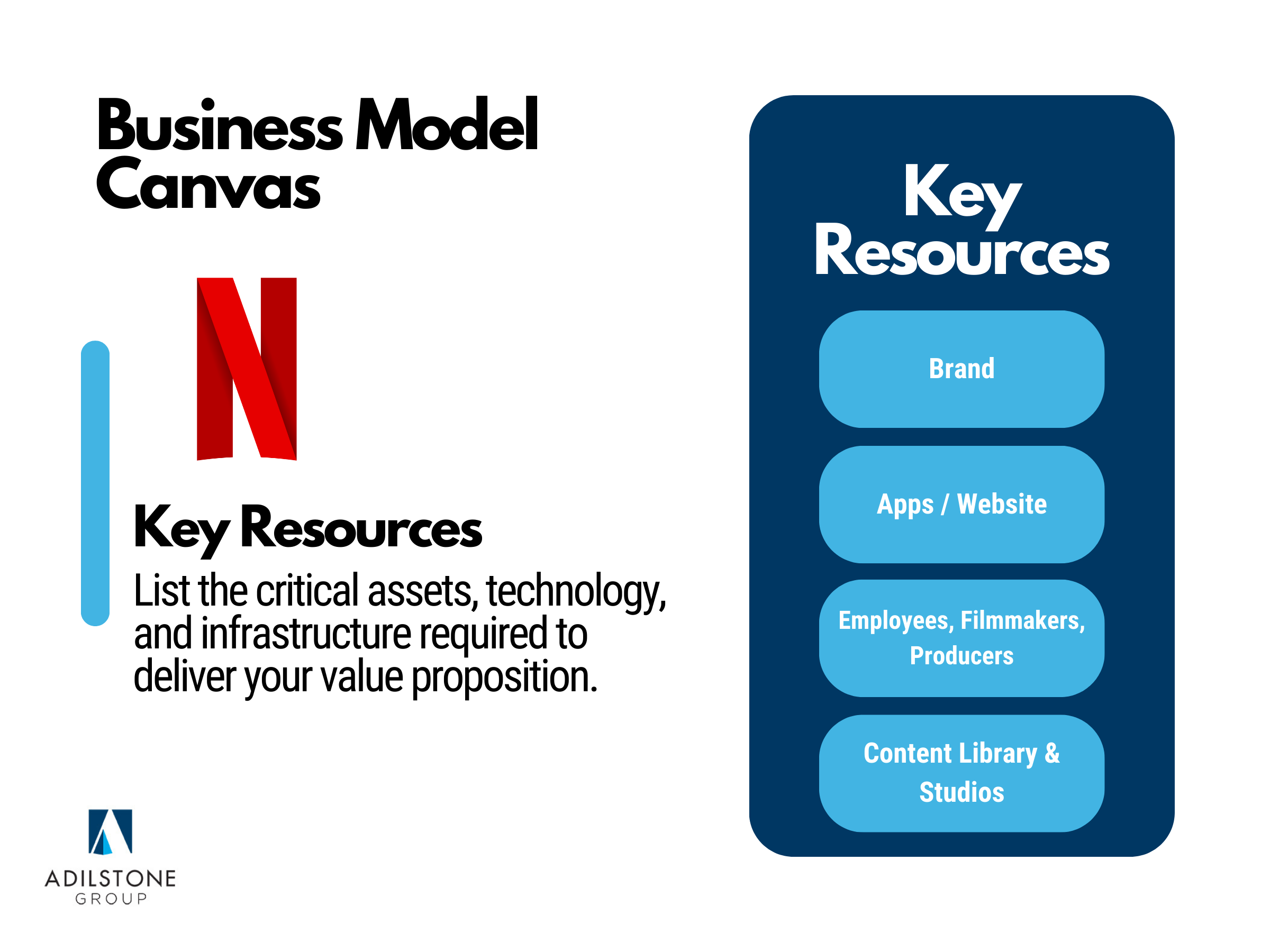
Netflix relies on a range of key resources to operate its streaming platform and maintain its position as a global entertainment leader. These resources are essential for content delivery, customer engagement, and technological innovation. Here are some of the key resources that drive Netflix's success:
- Brand
- Apps/Website
- Platform
- Employees, Filmmakers, & Producers,
- Content Library
- Studios
Netflix's extensive content library is one of its most critical resources. This library includes a vast array of movies, TV series, documentaries, and original programming. To maintain and expand this resource, Netflix invests heavily in content creation, licensing, and acquisitions.
Netflix's brand recognition and reputation as a leading streaming platform are valuable resources. The brand's positive perception attracts both subscribers and top talent in the entertainment industry. They are ranked in the top 100 global brands.
The company’s app and website are key resources for delivering its content and the company couldn’t live without its employees, filmmakers, and producers who maintain the platform, develop content, work with writers, and foster relationships with producers. Furthermore, Netflix has its own studios to help develop its content.
These resources collectively enable Netflix to deliver a compelling streaming experience to its subscribers and maintain its leadership in the highly competitive entertainment industry.
Now let’s look at Netflix’s key activities.
Key Activities
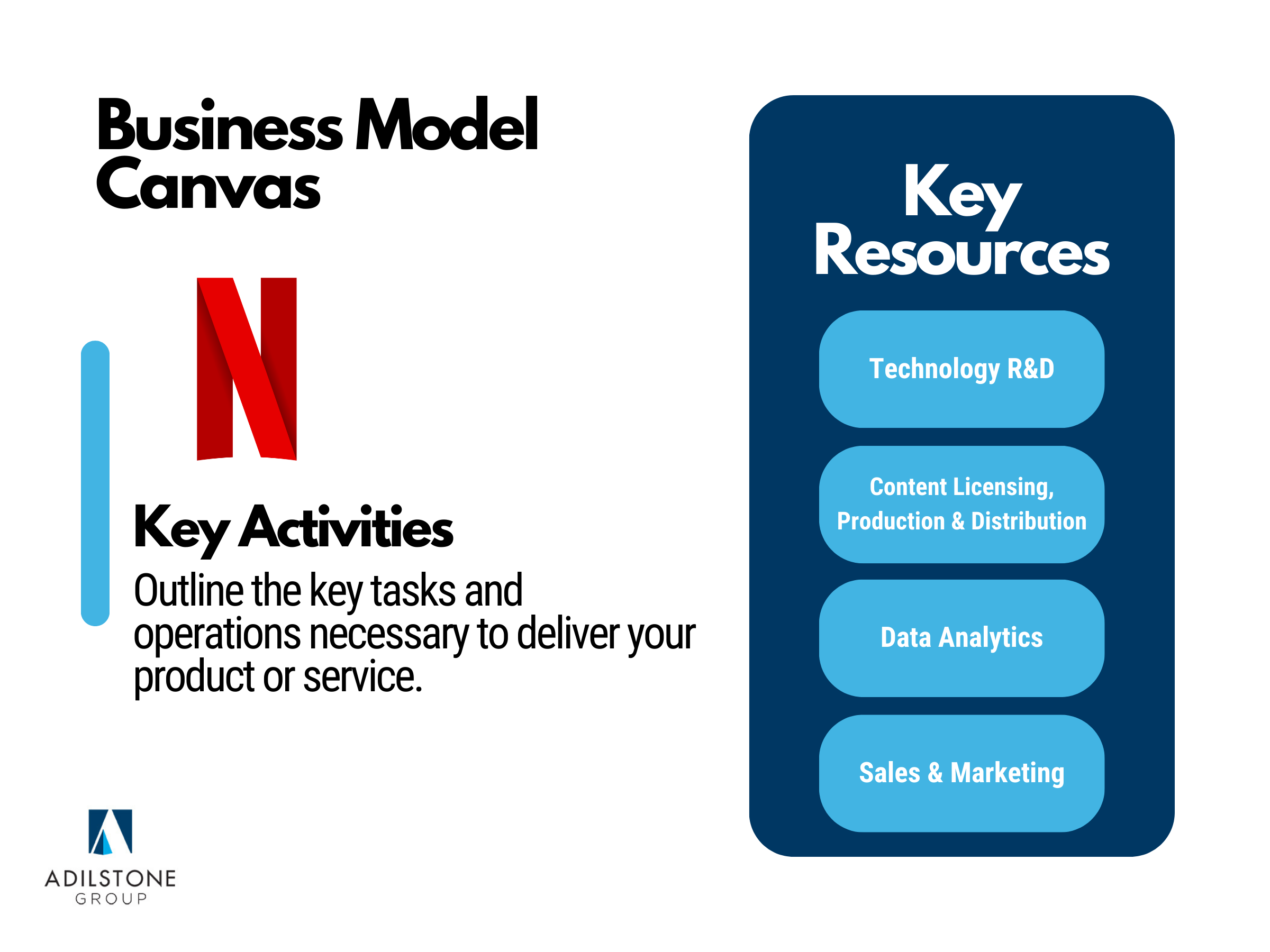
The next stage involves identifying the essential tasks and competencies necessary to create value for your customers.
This is where key activities come in.
Let’s look at Netflix’s:
- Technology R&D
- Content Licensing, Production, & Distribution
- Data Analytics
- Sales and Marketing
Netflix invests significantly in technology R&D to continually enhance its streaming platform. This includes developing and refining the algorithms behind content recommendations, improving video streaming quality, and optimizing user interfaces for various devices. Additionally, Netflix explores emerging technologies such as artificial intelligence and machine learning to enhance the viewer experience.
Netflix also heavily leverages data analytics to inform its decisions. Data analytics activities include collecting, processing, and analyzing vast amounts of viewer data. Netflix uses this data to understand viewer preferences, refine content recommendations, optimize content production, and target its marketing efforts effectively.
Sales and marketing activities at Netflix encompass a range of efforts to acquire and retain subscribers. This includes creating compelling marketing campaigns, promoting original content, running advertising campaigns, and leveraging customer data for personalized recommendations.
These activities collectively contribute to the company's growth, subscriber retention, and its ability to produce compelling original content that keeps viewers engaged.
We’re close to the end. Let’s move on to key partners.
Key Partners
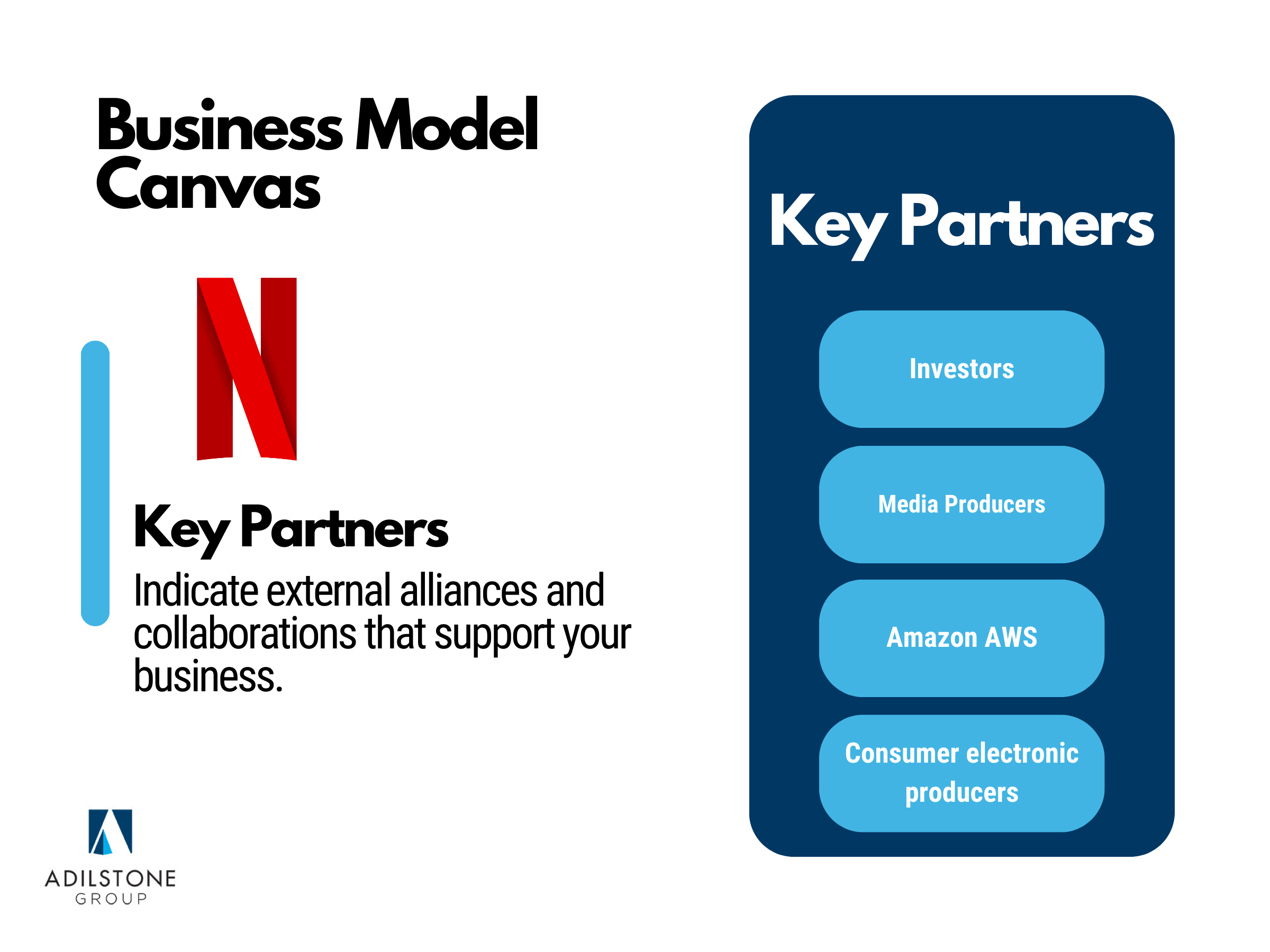
Netflix has a large group of key partners that are crucial in supporting their business. Here are a few of them:
- Investors
- Media producers
- Filmmaker guilds
- Cinemas and theaters
- TV Networks
- Consumer electronic producers
- Amazon AWS
- Regulators
Netflix relies on investors to secure the necessary funding for its content production, international expansion, and technology infrastructure. By maintaining a positive relationship with investors, the company can access capital markets and secure the financial resources needed for growth and innovation.
Media producers, including major studios, networks, and independent production companies, are vital partners for Netflix. These partnerships involve content licensing agreements, co-productions, and collaborations to create and distribute a wide variety of content. Netflix's ability to secure popular and high-quality content from these partners is crucial in attracting and retaining subscribers.
Netflix relies on Amazon AWS as a strategic technology partner for its cloud computing and hosting needs. Netflix's vast library of content and global streaming service require a highly scalable and reliable infrastructure. Amazon AWS provides the necessary cloud-based services and infrastructure to ensure that Netflix can deliver its content seamlessly to viewers worldwide.
Netflix partners with consumer electronic producers to ensure its streaming service is available on a wide range of devices, including smart TVs, smartphones, tablets, gaming consoles, and streaming media players. Collaborations with manufacturers such as Samsung, LG, Apple, Sony, and others enable Netflix to reach viewers on their preferred devices and platforms. These partnerships enhance the accessibility and convenience of the service.
These key partnerships are instrumental in Netflix's ability to deliver a compelling streaming experience to its subscribers
Finally, let’s finish our look at the business model canvas with cost structure.
Cost Structure
Netflix's cost structure reflects its significant investments in content creation, technology, marketing, and talent. Here are some of their main costs:
- Research and Development
- Content Purchases and Production
- Infrastructure
- Marketing
- General / Admin
- Employees
Netflix allocates a substantial portion of its budget to R&D activities aimed at enhancing the user experience and personalization.
This includes the development and maintenance of algorithms for content recommendations, improving streaming technology, and refining the user interface across various devices. The costs associated with R&D encompass salaries for engineers, data scientists, and software developers, as well as investments in technology infrastructure.
Content acquisition and original content production are among Netflix's largest expenses.
The company's commitment to a vast and diverse library of content, including original series, movies, and documentaries, requires substantial investments.
These costs cover licensing fees for third-party content, production costs for original content (e.g., salaries for actors, directors, and crew), post-production, and marketing of content.
Marketing is crucial to attract and retain subscribers, promote original content, and support international expansion efforts.
Netflix invests heavily in marketing campaigns across various media channels, including digital advertising, television, billboards, and social media. The costs associated with marketing encompass advertising spend, creative development, and promotional activities aimed at driving subscriber growth.
Netflix's infrastructure costs include expenses related to data centers, content delivery networks (CDNs), and cloud computing services (e.g., Amazon AWS) for hosting and delivering its streaming content.
Additionally, maintaining a global network of employees, including engineers, content creators, customer support staff, and administrative personnel, is a significant portion of the cost structure. Employee-related costs include salaries, benefits, and training.
By investing in a vast library of content, improving the user experience, and expanding its global reach, Netflix has attracted a large and loyal subscriber base. The company's willingness to allocate resources to content creation and innovation reflects its commitment to maintaining its leadership in the streaming entertainment industry.
Once you’ve completed these 9 steps, your Business Canvas Model should look something like this:
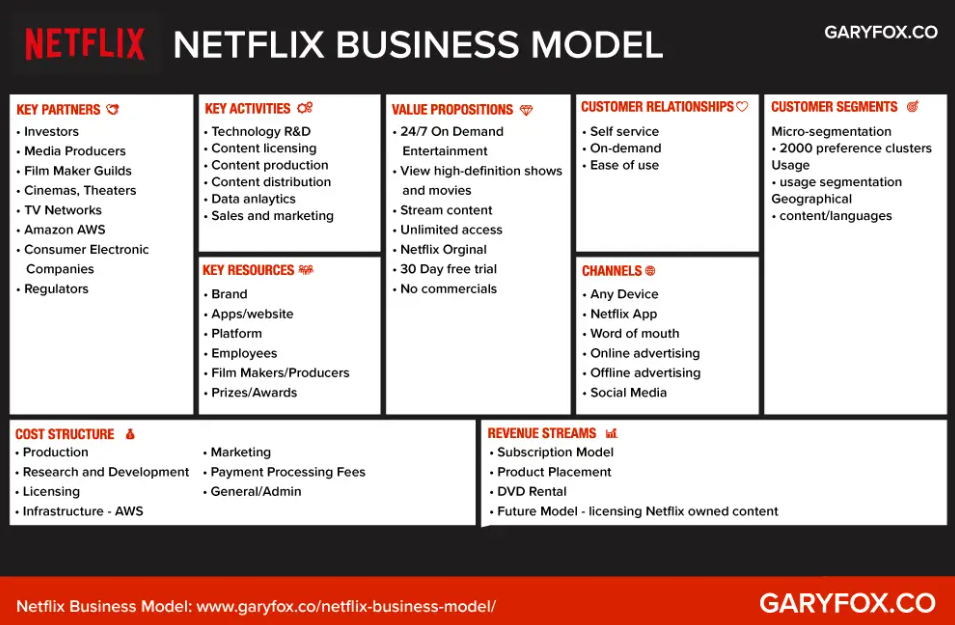
How to Analyze Your Business with the BMC
1. Map your existing business model:
Start by filling in each of the nine building blocks on the canvas based on your current business model. This process encourages cross-functional collaboration, as it often requires input from various teams within your organization.
2. Identify strengths and weaknesses:
Analyze your canvas to identify strengths and weaknesses in your business model. For instance, you may discover that you have a strong value proposition but struggle with the cost structure.
3. Explore opportunities for innovation:
The Business Model Canvas is a powerful tool for brainstorming and ideation. Use it to explore potential changes and innovations in your business model. Consider questions like: Can you offer a new value proposition to an existing customer segment? Are there untapped customer segments you could serve?
4. Test assumptions and hypotheses:
The BMC can help you test assumptions and hypotheses about your business. For example, you may hypothesize that a new channel or partnership will improve your customer acquisition. By adjusting the canvas accordingly, you can visualize the potential impact of these changes.
5. Adapt and iterate:
As your business evolves, revisit and update your Business Model Canvas regularly. This ensures that your strategy remains aligned with your changing environment and customer needs.
Conclusion
In today's dynamic business environment, companies must continuously assess and adapt their business models to thrive. The Business Model Canvas offers a structured and visual approach to understanding, analyzing, and innovating business models. By regularly revisiting and iterating on the canvas, companies can maintain their competitiveness and drive sustainable growth.
Related Content




Comments